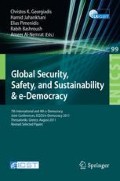Abstract
We discuss the networking dimension of the Integrated Platform for Autonomic Computing (IPAC). IPAC supports the development and running of fully distributed applications that rely on infrastructureless (ad-hoc) network with multi-hop transmission capabilities. Such environment is typically used for the realization of collaborative context awareness where nodes with sensors “generate” and report context while other nodes receive and “consume” such information (i.e., feed local applications with it). Due to its highly dynamic character this application environment, an efficient solution for the dissemination of information within the network involves the adoption of epidemical algorithms. With the use of such algorithms, a certain node spreads information probabilistically to its neighborhood. Evidently this is a rational approach since the neighborhood changes frequently and nodes are not necessarily in need of the generated contextual stream. IPAC mainly targets embedded devices such as OS-powered sensor motes, smartphones and PDAs. The platform relies on the OSGi framework (a popular middleware for embedded devices) for component deployment, management and execution. We discuss implementation issues focusing on the broad spectrum of IPAC services that were developed in order to facilitate applications. We elaborate on the networking stack that implements epidemical dissemination. We also discuss how such infrastructure has been used to realize applications related to crisis management and environmental protection. We present an adaptive flavor of the epidemical dissemination which expedites delivery by tuning the forwarding probability whenever an alarming situation is detected.
Access this chapter
Tax calculation will be finalised at checkout
Purchases are for personal use only
Preview
Unable to display preview. Download preview PDF.
References
Lie, T.T.: Fire temperature time relations. The SFPE Handbook of Fire Protection Engineering (1988)
Manolakos, E.S., Manatakis, D.V., Xanthopoulos, G.: Temperature field modeling and simulation of wireless sensor network behavior during a spreading wildfire. In: 16th European Signal Processing Conference, EUSIPCO (2008)
Stroup, D., DeLauter, L., Lee, J., Roadarmel, G.: Fire Test of Men’s Suits on Racks. In: Proc. Report of Test FR 4013, p. 25 (2001)
Pitts, W., Braun, E., Peacock, R., Mitler, H., Johnsson, E., Reneke, P., Blevins, L.: Temperature Uncertainties for Bare-Bead and Aspirated Thermocouple Measurements in Fire Environments. In: Proc. Annual Conference on Fire Research, pp. 15–16 (1999)
Kurt, F.: Prometheus Fire Growth Model: Design and Incorporation of Spotting and Breaching of Fire Break Functionality. In: Post-Fire Research Workshop (2005)
Butler, B., Cohen, J.: A Theoretical Model Based on Radiative Heating. Int. J. Wildland Fire 8(2), 73–77 (1998)
Boccaletti, S., Latora, V., Moreno, Y., Chavez, M., Hwang, D.: Complex Networks: Structure and Dynamics. Phys. Rep. 424, 175–308 (2006)
Zervas, E., Mpimpoudis, A., Anagnostopoulos, C., Sekkas, O., Hadjiefthymiades, S.: Multisensor Data Fusion for Fire Detection. In: Information Fusion, vol. 12(3). Elsevier (2011)
Author information
Authors and Affiliations
Editor information
Editors and Affiliations
Rights and permissions
Copyright information
© 2012 ICST Institute for Computer Science, Social Informatics and Telecommunications Engineering
About this paper
Cite this paper
Gerakos, K., Anagnostopoulos, C., Hadjiefthymiades, S. (2012). Tuning the Epidemical Algorithm in Wireless Sensor Networks. In: Georgiadis, C.K., Jahankhani, H., Pimenidis, E., Bashroush, R., Al-Nemrat, A. (eds) Global Security, Safety and Sustainability & e-Democracy. e-Democracy ICGS3 2011 2011. Lecture Notes of the Institute for Computer Sciences, Social Informatics and Telecommunications Engineering, vol 99. Springer, Berlin, Heidelberg. https://doi.org/10.1007/978-3-642-33448-1_5
Download citation
DOI: https://doi.org/10.1007/978-3-642-33448-1_5
Publisher Name: Springer, Berlin, Heidelberg
Print ISBN: 978-3-642-33447-4
Online ISBN: 978-3-642-33448-1
eBook Packages: Computer ScienceComputer Science (R0)

